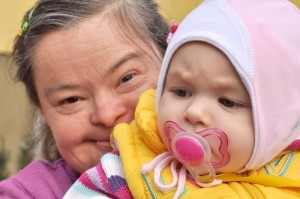
Historically, many women with intellectual disabilities were not supported to have children, due to the nature of institutionalised practice and many women were sterilised to prevent them from having children (McConnell et al, 2008).
However, more and more women with intellectual disabilities are having children. In order to investigate differences between mothers with and without intellectual disabilities, the authors used an archival dataset (the Oxford Record Linkage Study; ORLS) to examine pregnancies and childbirth outcomes.
Materials and methods
The ORLS was a dataset comprised of routinely collected statistical records of hospital care in Oxfordshire and West Berkshire and although it started in 1963 and ended in 1999, the authors chose to focus on maternity and delivery records between 1970 and 1989.
Trained clerical staff on maternity units recorded a structured summary for each mother and baby at the time of discharge from the hospital. Each mother and baby pair were assigned a single unique identifier, and the mother’s record and the baby’s record also included this number and this allowed all other records for the mother and baby to be linked. That way, the authors were able to identify the mothers’ previous and subsequent hospital admissions and death (if it occurred) and the baby’s subsequent hospital admissions and death (if it occurred).
The identifiers were then stored in encrypted form, but then de-identified when they were archived in 1999.
Chi-squared tests were used to assess the significance of associations between mothers with intellectual disabilities and the following perinatal risk factors:
- The number of times the mother had previously given birth
- Whether the mother smoked during pregnancy *
- Social class* (determined by the occupation of the mother, if single, or the head of the household, of married)
- Whether the mother was breastfeeding at the time she was discharged from maternity care*
- Whether the baby was small for gestational age
- Stillbirth (if the baby died at or above 28 weeks gestation)
- Neonatal death (if the baby died within the first 28 days)
*Some of these data were not collected until 1975
Logistical regression was subsequently used to study the associations with each variable after allowing for the effects of the others.
Data were excluded if there records had implausibly low or high values (e.g. birth recorded as before 28 weeks or after 48 weeks, or birth weight of less than 1kg or more than 5.5kg), or if considerable data were missing.

More women with learning disabilities are having children and researchers in this study used an archival dataset to investigate differences in pregnancy and childbirth outcomes between mothers with and without learning disabilities
Results
The following results are derived from the initial analysis, where all the factors were analysed independent from one another.
The mother
The results indicated that 217 babies were born to mothers with intellectual disabilities out of a total of 245,007 births (0.9 per 1000 births). The rate of births to mothers with intellectual disability increased from 1980-1989 from the 1970s.
When examining the data, it appeared as though when compared to mothers without intellectual disabilities, mothers with intellectual disabilities were more likely to be younger (under 25), given birth more times and over represented in the least privileged social class, or not to have had their social class recorded.
They were also more likely to be unmarried and to have smoked during pregnancy. No mothers with intellectual disabilities were recorded as belonging to the most privileged social class.
Mothers with intellectual disabilities were not more likely to experience preeclampsia than mothers without intellectual disabilities and there was no significant difference between the weight of mothers with intellectual disabilities and mothers without.
The delivery and the baby
The results suggested that mothers with intellectual disabilities were not statistically more likely to have twins than mothers without intellectual disabilities, they were not statistically more likely to have complicated births (requiring the use of caesarean section or forceps delivery), nor were they statistically more likely to have babies of very low birth weight, and there were no statistical differences between the distress of the baby during delivery (as measured by the Apgar scores of the recorded one minute after birth).
However, babies born to mothers with intellectual disabilities were statistically more likely to have been overdue (born after 42 weeks’ gestation), more likely to have fairly low birth weights (between 2 and 3kg) and they were less likely to be breast fed at the time of discharge from maternity care (33%) compared to babies born to women without intellectual disabilities (70%).
Further analysis allowed for some of the variables to be combined, to see whether some of the findings were secondary to trends over time (year of birth) or social class associations. When social class and year of birth were controlled for, and when only the statistically significant variables were included in the analysis, mothers with intellectual disabilities were still statistically more likely to be of lower social class, unmarried, to have smoked during pregnancy and not breastfeeding at the time of their discharge from maternity care.
First time mothers
The authors also looked at the records of first time mothers with intellectual disabilities. Compared to other first time mothers, they were more likely to be younger, of lower social class, to have smoked during pregnancy, to have been unmarried, to not be breastfeeding and their babies were more likely to be less than 3kg when they were born.
Stillbirths and post-neonatal mortality rates
The results indicated that women with intellectual disabilities were more likely to have stillbirths (9.2%) than other mothers (5.5%), but this was not statistically significant.
Furthermore, the rates of neonatal and post-neonatal deaths were higher for mothers with intellectual disabilities compared to mothers without intellectual disabilities (14.0 per 1000 and 3.4%, respectively), which approached statistical significance.

Mothers with learning disabilities were more likely to be under 25, and to be over represented in the least privileged social class
Strengths and limitations
A strength of the current study is that the data come from a very large birth cohort of almost a quarter of a million births over 20 years and the there is no possibility of responder or reporting bias. However, despite this, the number of birth records for mothers with intellectual disabilities is low, and therefore, the study has fairly low statistical power.
When reading this paper, I was struck by the de-contextualised nature of the analysis. Given that the records were collected between 1970 and 1989, many women with intellectual disabilities may well have been receiving care within long stay hospitals, because they predated the shift from hospital to community care in the 1990s.
This could help to explain the observed differences in social class; mothers with intellectual disabilities were more likely to be social disadvantaged. The authors acknowledged that this was because social class was dependent on occupation and many women with intellectual disabilities may well have not had opportunities to work between 1970 and 1989, or have been in long-stay hospitals.
Thinking about institutionalisation may also potentially help to explain observed differences in smoking; often within inpatient settings, smoking is seen as an accepted practice, where service users can use smoking as an activity as well as a means of punctuating long days.
Furthermore, the principles of empowerment, personalisation and mainstreaming were not dominant in healthcare practice at that time; therefore, women may not have been encouraged to get married. Furthermore, given that many people within institutional care may have experienced sexual abuse, when reading this paper, we should be mindful about issues of capacity and consent to sexual activity.
In addition, the differences observed in breast feeding are curious; when babies are very young, one of the most important factors in neonatal wellbeing is how well the baby feeds and if they gain weight.
However, breast feeding can be a difficult skill to learn for some mothers and depends on complex dynamics between mother and baby. One possibility that crossed my mind when thinking about this was that midwives and health visitors may well have been potentially risk averse when supporting mothers with intellectual disabilities and their babies and encouraged bottle feeding, which allows for objective observation of how much milk an infant has drunk.
I was also curious about the higher rates of stillbirth and neonatal and post-neonatal deaths; it would have been useful if the authors would have been able to provide some information that could have helped to explain why these findings might have been observed.
Summary
The results indicated that, generally the outcomes of the babies born to mothers with intellectual disabilities were comparable to mothers without intellectual disabilities. The main differences were found between the mothers and the rates of stillbirths and neonatal and post-neonatal deaths.
It would be interesting to compared epidemiological data collected from 1990-2009, to see whether social and political changes have resulted in changes to pregnancy and birth outcomes for women with intellectual disabilities.
The authors made various recommendations for how health professionals could improve health care for mothers with intellectual disabilities: providing personalised support for smoking cessation and breastfeeding support, including carers and families to help with communication, giving mothers more time and using visual aids and repetition to help aid mothers’ understanding of information.

Data used in this study were from between between 1970 and 1989. Would more recent data show any impact on outcomes from social and political changes?
Links
Primary paper
, , and (2015), Childbirth in women with intellectual disability: characteristics of their pregnancies and outcomes in an archived epidemiological dataset in Journal of Intellectual Disability Research, 59, 653–663 [abstract]
Other references

‘de-contextualised nature of the analysis’ Great example of value of @LearningDisElf review https://t.co/Ooh1TA1x3E https://t.co/FfIogIEm27
@HannahnagroM @LearningDisElf thank you for the kind commentary
Pregnancy and childbirth outcomes in women with intellectual disabilities between 1970 and 1989 https://t.co/MdVzv9x1gT
Mothers with LD were more likely to be under 25, and to be over represented in the least privileged social class https://t.co/wvIGFzsGwU
Don’t miss: Pregnancy and childbirth outcomes in women with intellectual disabilities between 1970 and 1989 https://t.co/wvIGFzsGwU #EBP
I wrote this about a study of outcomes for mothers and babies with ID between 1970 and 1989 for the @LearningDisElf. https://t.co/RciNlL0FOL
Pregnancy and childbirth outcomes in women with intellectual disabilities between 1970 and 1989 https://t.co/TGeqtw5h6G via @sharethis